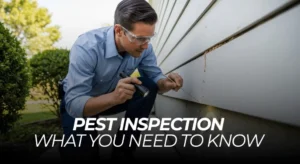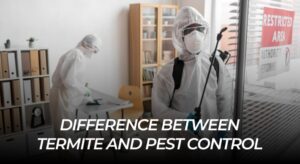Pest treatment is a method of control or elimination, or prevention of undesired insects infiltrating your property. Professional care facilities offer specific measures against a particular insect issue, but at the same time reduce risks to human life and pets. Knowing when and how to conduct the pest treatment can save you some money, time, and even risk to your health.
Most of the homeowners opt to consult after noticing an open infestation. The intensity of attempts at early intervention, however, can be more effective and less expensive as compared to eradicating established pest colonies. A little knowledge of pest care can assist you in making the right choices regarding the care of your property and family.
Typical Pest Treatment Methods
Serious infestations continue to be solved most often with chemical methods. Professional exterminators utilize the application of pesticides in specific regions where pests reside, reproduce, or move. Such treatments are usually effective and fast acting though they should be applied with much caution.
Biological control of pests, also known as biocontrol, used to control pensive populations by predators or pathogens in nature. This green procedure is efficient in long-term prevention, but can require more time before it can become evident. Most residential consumers use a combination of biological and alternative measures to control pests all round.
Read More: How To Do Pest Control At Home Yourself
Symptoms of Pest Treatment Indication
Pest sightings during the daytime hours are very likely to be evidence of a major infestation that needs to be addressed right away. Pests are most of the time nocturnal, and thus their prevalence during the day indicates an overcrowding of their sheltering sites. Several sightings in various parts of your home will indicate that it is a widespread problem.
Property damage is another clear sign that pest treatment is required. Chewed wires, ruined wood buildings, and holes in the walls indicate that the pests are active. Weird smells, weird noises in walls, or the detection of pest excreta is also a reason to call in a professional tool expert.
Seasonal Pest Treatment Considerations
The start of spring sees a rise in pest activity as temperatures rise and breeding seasons speed up. Numerous insects come out of hibernation in search of food and nesting places in your home. Small issues can be solved before they turn out to be serious cases by treating them early in spring.
The warm weather in summer is favourable, as the weather stimulates the pests to breed numerous times. The monitoring and prevention treatment in these months carries out regular check ups and treatment thus keeping the season in control. When treating in fall, emphasis is on keeping the pests out of the house as they search refuge during winter.
Read More: Seasonal Pest Control Checklist for Homeowners
Health Hazards of Common Pests
Health droop posed by disease transmission is the most threatening issue about the infestation of pests. Rodents are known to transmit salmonella, hantavirus, and plague since their urine and droppings contain these diseases. Cockroaches cause food poisoning due to bacteria they carry on leaving aside asthma attacks instigated by the insect.
Biting spiders, biting wasps, and other venomous pests are direct physical threats. Others develop severe allergic reactions that need emergency medical care. Bed bugs do not carry disease, but psychological stress and sleep disturbance can result in total well-being.
When to Choose DIY vs Professional Treatment
- Infestation of common problematic pests, such as ants or fruit flies, that are small and small-scale, can go very well with DIY options.
- Small problems that are caught early are effectively treated by the use of over-the-counter sprays and baits.
- The simple preventive measures, such as sealing cracks and eliminating food sources, contribute to environmental conditions that do not have pests.
- When the DIY tools do not come to the rescue, even with continued efforts, professional treatment is warranted.
- Harmful and risky insects such as wasps, poisonous spiders, or a great number of rodents need professional treatment..
- Professional intervention requires them to be achieved within a very short time, since the structural damage or health risk should be addressed urgently.
Read More: Mistakes that attracts Pests
Cost Factors in Pest Treatment Services
Prices of treatment depend considerably on which kind and how serious your pest issue is. Small pest control, such as ant or cockroach methods, is normally cheaper than elaborate termite or rodent removal policies. Pricing also depends on the size of your property as well as the number of areas affected.
It is common that emergency healthcare measures involve increased charges as compared to routine preventive care. Most pest management firms will give you packages with constant support. The strategy to shop quotes for various services is what will give you a fair measure in terms of what you pay to get a quality service.
Making-Ready Your Home Against Pest Treatment
Cleaning the treatment places will enable exterminators to gain more access to areas where the pests camouflage in. Personal items, food, and pets should be removed from any area where chemical application areas are. Cover or take away dishes, utensils, and food preparation surfaces until treatment commences.
Your pest control professional only needs some communication with you so that effective treatment can be applied. Ask whether any pets, children, residents, or individuals have chemical sensitivity concerns. The best service will be obtained by following all the pre-treatment steps.
Long-term Pest Prevention Plans
Household maintenance avoids most pest issues until they are eliminated by professional services. Caulk holes around windows, door frames, and foundation so that pests do not get through. Make sure vegetation does not grow around your house’s external walls and roof eaves.
The prevention of moisture is very important as most insects and rodents are in need of water. Repair wet pipes, maintain adequate ventilation in damp spaces and drain water around your building. Clean food crumbs and food spillage, as soon as possible to prevent visible food items.
Effects of Pest Treatments on the Environment
The modern approach to pest control has the focus on integrated pest management (IPM) as a way of reducing negative environmental influence. The strategy integrates various control mechanisms and lessens the attempt of using chemical pesticides. Prevention, monitoring, and specific treatments when needed are used as strategies in IPM.
Greener treatment applications are still on the increase as consumers are requesting greener alternatives. Environmentally friendly homeowners have quick solutions to conventional pesticide use: the use of natural and organic pesticides. Nevertheless, very bad infestations can still be treated with the help of more traditional methods to clear them.
Informed Choice in Pest Treatment
Knowing what kind of pest your problem is will assist in selecting the most effective treatment method. This is because various pests need different approaches, timing, as well as subsequent procedures in ensuring that they are out of control. Search for a good pest control company representative with pest control experience in dealing with your pest problems.
The use of pest treatment is a must when it comes to a healthy and comfortable living environment, left from unnecessary visitors. Most pest problems can be tackled effectively using proper training and experience without causing harm to your home and loved ones.







